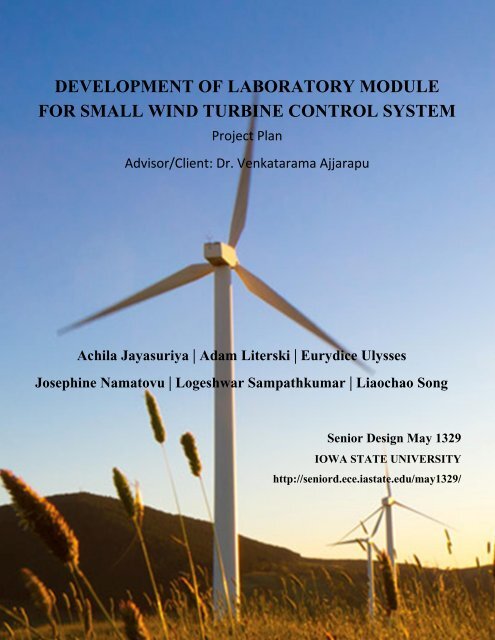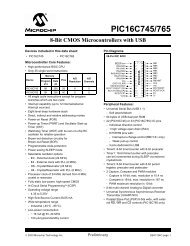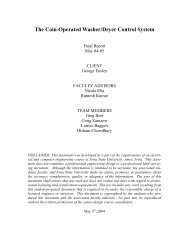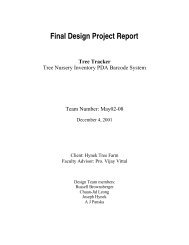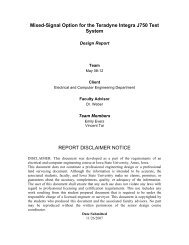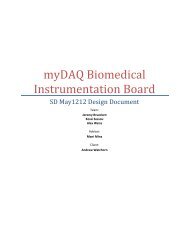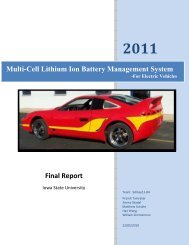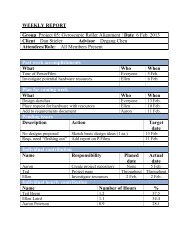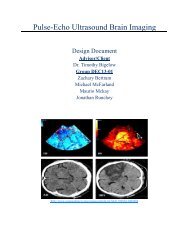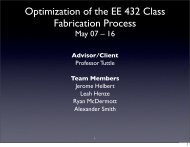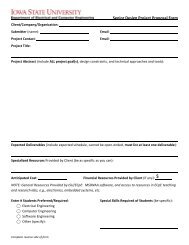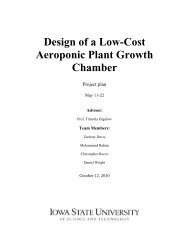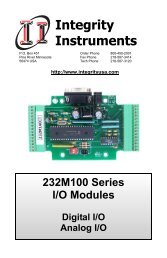Download File - Senior Design - Iowa State University
Download File - Senior Design - Iowa State University
Download File - Senior Design - Iowa State University
Create successful ePaper yourself
Turn your PDF publications into a flip-book with our unique Google optimized e-Paper software.
DEVELOPMENT OF LABORATORY MODULE<br />
FOR SMALL WIND TURBINE CONTROL SYSTEM<br />
Project Plan<br />
Advisor/Client: Dr. Venkatarama Ajjarapu<br />
Achila Jayasuriya | Adam Literski | Eurydice Ulysses<br />
Josephine Namatovu | Logeshwar Sampathkumar | Liaochao Song<br />
<strong>Senior</strong> <strong>Design</strong> May 1329<br />
IOWA STATE UNIVERSITY<br />
http://seniord.ece.iastate.edu/may1329/
DEVELOPMENT OF LABORATORY MODULE FOR SMALL WIND TURBINE CONTROL SYSTEM GROUP – MAY 1329<br />
PROBLEM STATEMENT<br />
Wind is one of the clean sources of renewable energy used in the United <strong>State</strong>s. Most<br />
wind energy comes from turbines that can be as tall as 130 - 400 feet, and have three 200-footlong<br />
blades.<br />
Our objective is to develop a laboratory module for a small wind turbine system that will<br />
resemble a small scale renewable electric system. This will be a learning module for students<br />
interested in familiarizing themselves with wind power generation. In order to accomplish this,<br />
we will take wind measurements and simulations to get a power output at a given system.<br />
CUSTOMER NEEDS<br />
The system should accurately simulate wind conditions implemented in MATLAB to the<br />
turbine, which is coupled to a motor<br />
Voltage, current, power, and speed of all components should be easily monitored used in<br />
the system<br />
Presence of a suitable control system so that load first utilizes the power produced by the<br />
wind and, use the battery as a backup power supply<br />
There should be a graphical user interface (GUI) for the control system in LabView for<br />
easier visual communication<br />
SYSTEM DESCRIPTION<br />
This project acts as an educational tool for students learning about the effects of wind<br />
energy on a power system. The objective of the project is to take wind measurements and<br />
simulate the power output to the system. Being Phase V of the project, our goal is to improve the<br />
existing system and build upon or alter Phase IV according to the required specifications.<br />
Sub-Group 1: Hardware Testing<br />
Rearranging Phase IV circuitry and rebuilding upon hardware wiring to match schematic<br />
while maintaining secure connections.<br />
Soldering rectifier and buck-boost components of the circuits, and rewiring the induction<br />
generator into working condition.<br />
Mounting modules inside the buck-boost converter, PWM, and current transformer in<br />
order to restrict wobbling and to maintain safe conditions.<br />
Worked with Mr. Harker to set up the variable voltage source to the induction motor.<br />
Sub-Group 2: Software Simulation<br />
Implementing NI Multisim and MATLAB PLECS in order to design and simulate the<br />
rectifier, regulator, PWM, and buck-boost components of the circuit.<br />
Listing all datasheets for parts and components required for the design of the circuitry,<br />
and collaborating with Hardware Team with regards to parts that need to be purchased.<br />
1 Advisor / Client : Dr. Venkataramana Ajjarapu
DEVELOPMENT OF LABORATORY MODULE FOR SMALL WIND TURBINE CONTROL SYSTEM GROUP – MAY 1329<br />
Collaborating with Hardware Team regarding voltage, current, power, and frequency<br />
input and output requirements for the overall system.<br />
Calculating parameter values for circuit components and ensuring they contribute to the<br />
above requirements as per the Hardware Team’s recommendations.<br />
2 Advisor / Client : Dr. Venkataramana Ajjarapu
DEVELOPMENT OF LABORATORY MODULE FOR SMALL WIND TURBINE CONTROL SYSTEM GROUP – MAY 1329<br />
SYSTEM BLOCK DIAGRAM<br />
The Induction motor speed is<br />
varied based upon the<br />
available wind data<br />
The Variable AC gets<br />
converted into variable DC<br />
by the Advanced<br />
Wheatstone’s Bridge<br />
Rectifier<br />
The Variable DC<br />
gets converted into<br />
a desirable DC<br />
range of 21-34 V<br />
The Available source is then<br />
compared with the load and<br />
based upon the percentage,<br />
appropriate sequence is<br />
selected<br />
The DC input gets inverted<br />
and then supplied to the load<br />
3 Advisor / Client : Dr. Venkataramana Ajjarapu<br />
Excess generation is stored in<br />
the batteries for future<br />
usage. Also when fully<br />
charged it gets used
DEVELOPMENT OF LABORATORY MODULE FOR SMALL WIND TURBINE CONTROL SYSTEM GROUP – MAY 1329<br />
ASSIGNED RESPONSIBILITIES<br />
Hardware Group:<br />
Adam Literski – Breakdown of system requirements/adjust project desires/analyze<br />
minimum components<br />
Achila Jayasuriya – Test old components and functionality. In addition repair broken<br />
components.<br />
Logeshwar Sampathkumar – Optimize wiring and read schematic wiring diagrams for<br />
correct wiring diagram setup.<br />
Software Group:<br />
DELIVERABLES<br />
Liaochao Song – Research given phase (4) programs and merging new changes with<br />
old.<br />
Eurydice Ulysses – Redesign and test Pulse Width Module/Buck-Boost converter<br />
Josephine Namatovu – Redesign and test rectifier<br />
Our expected end product will provide a multilayered system that will allow variation<br />
input determined on gathered wind data which will control our induction motor. Depending on<br />
motor output will determine what level of the circuit will be engaged and what wont. Our<br />
client/advisor requested that we get of one chamber from our senior design group.<br />
Case 1: Power output over exceeds demand<br />
This option will engage the main system of the rectifier, pulse width module, and<br />
buck/boost converter from the induction power. The main supply will transition to the inverter<br />
that will then power our load. In addition from that there will be another side system with pulse<br />
width module and buck/boost converter charging the battery with the additional power. Once<br />
fully charged it will dissipate the excess power.<br />
Case 2: Power output meets demand<br />
This option will engage the main system of the rectifier, pulse width module, and<br />
buck/boost converter from the induction power. The main supply will transition to the inverter<br />
that will then power our load. There will be no charging of the battery in this case.<br />
Case 3: Power output less then demand<br />
This option will engage the main system of the rectifier, pulse width module, and<br />
buck/boost converter from the induction power. The main supply will transition to the inverter<br />
that will then power a portion of load. The remaining power will be made up from our battery<br />
portion of our system until its depleted voltage.<br />
4 Advisor / Client : Dr. Venkataramana Ajjarapu
DEVELOPMENT OF LABORATORY MODULE FOR SMALL WIND TURBINE CONTROL SYSTEM GROUP – MAY 1329<br />
Required <strong>Design</strong> & Technical Documents<br />
Project Plan Document<br />
Project <strong>Design</strong> Document<br />
OPERATING ENVIRONMENT<br />
When simulating the system, everything will be done in a controlled lab environment<br />
where the induction motor will be mounted to a table. The original design of the wind turbine<br />
was going to be placed on a building in the university, however due to safety reasons that got<br />
changed. Therefore, the project is centrally located in our power systems lab. Since our AC<br />
induction motor is in replace of our wind turbine, we will manually record our readings at set<br />
values relating to our wind sensor. The wind senor will accurately record real wind conditions so<br />
we can simulate real wind condition.<br />
PRECAUTIONS<br />
Follow the laboratory rules and regulations, and read the laboratory safety manual<br />
Read the manuals for the equipment in the lab<br />
At least two people should be in the laboratory at all times when working on the project<br />
All team members should sign in whenever using the laboratory<br />
Take note of the standards required for this project i.e. the IEEE standards<br />
FUNCTIONAL REQUIREMENTS<br />
Motor<br />
Motor is to simulate outdoor wind speed with 1.5 Horsepower; Motor has maximum<br />
frequency 60 Hz and maximum voltage 230V. The full load amps is 4.08 A and full load rpm is<br />
3570 rpm.<br />
Turbine<br />
Turbine will generate 24V DC output; Turbine generator will have a 400W peak output;<br />
the turbine will supply the battery bank when the batteries are below 24V; Input DC voltage is<br />
between 21 and 34 volts.<br />
Wind vane and anemometer to transmit outdoor wind profiles<br />
NON-FUNCTIONAL REQUIREMENTS<br />
Documented technical manuals and in-depth schematics<br />
Motor will be remounted onto a stable operation platform.<br />
Labeling of the individual wirings to have easier understanding of breakdown of system.<br />
Optimize wiring so system is easy to understand<br />
5 Advisor / Client : Dr. Venkataramana Ajjarapu
FUNDING<br />
DEVELOPMENT OF LABORATORY MODULE FOR SMALL WIND TURBINE CONTROL SYSTEM GROUP – MAY 1329<br />
LIMITATION<br />
Funding Amount<br />
Client – Dr. Venkatramana Ajjarapu $500.00<br />
Total $500.00<br />
Controlled environment inside power lab in Coover<br />
$500 budget leaves little room for equipment malfunctions<br />
The project will comply with all state and federal regulations<br />
Discrepancies in schematics and wiring diagrams from previous group's work<br />
The system needs to be easy to use for the average undergraduate student<br />
CONTACT INFORMATION<br />
FACULTY ADVISOR & CLIENT Email<br />
Dr. Venkataramana Ajjarapu vajjarap@iastate.edu<br />
TEAM MEMBERS<br />
Adam Literski (Team Lead) literski@iastate.edu<br />
Achila Jayasuriya (Hardware Lead) achila@iastate.edu<br />
Eurydice Ulysses (Communication Liason) eulysses@iastate.edu<br />
Josephine Namatovu (Project Lead) josephin@iastate.edu<br />
Logeshwar Sampathkumar (Web Master) sklogesh@iastate.edu<br />
Liaochao Song (Software Lead) lsong@iastate.edu<br />
TIMELINE – CLICK HERE<br />
6 Advisor / Client : Dr. Venkataramana Ajjarapu


